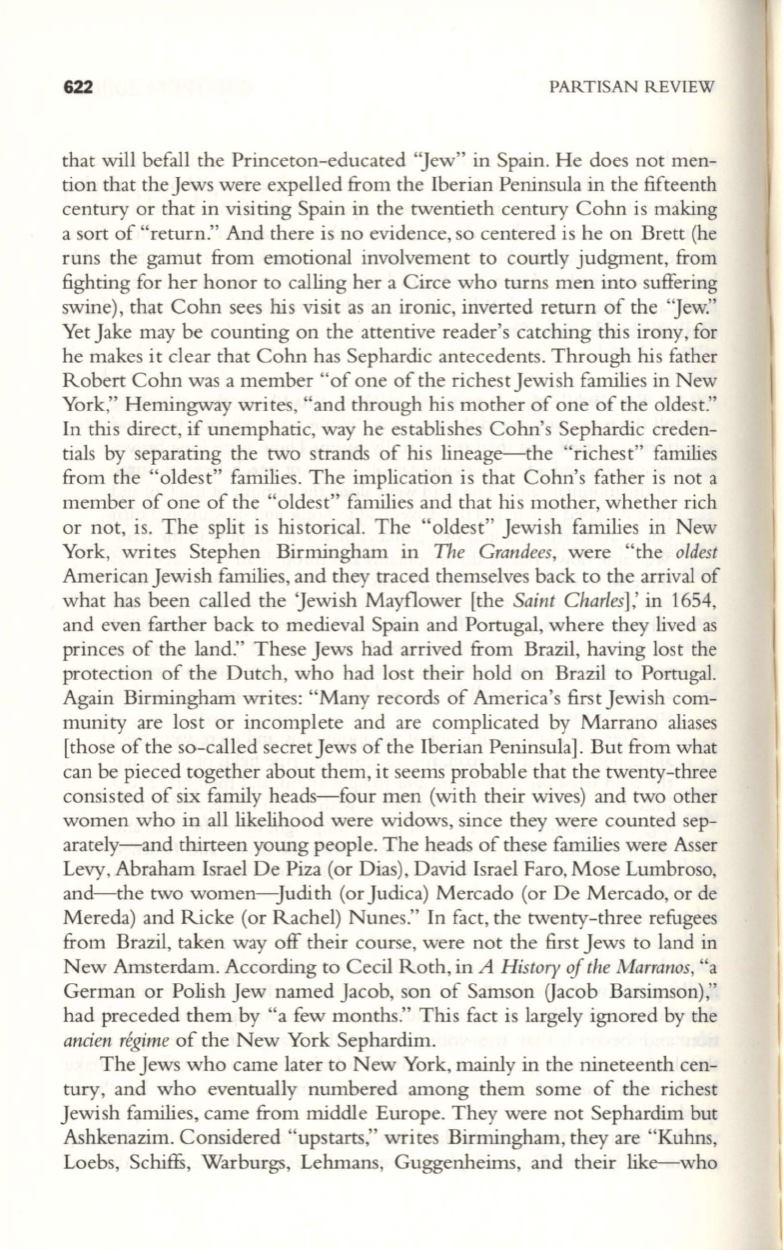
622
PARTISAN REVIEW
that will befall the Princeton-educated "Jew" in Spain. He does not men–
tion that the Jews were expelled from the Iberian Peninsula in the fifteenth
century or that in visiting Spain in the twentieth century Cohn is making
a sort of "return." And there is no evidence, so centered is he on Brett (he
runs the gamut from emotional involvement to courtly judgment, from
fighting for her honor to calling her a Circe who turns men into suffering
swine), that Cohn sees his visit as an ironic, inverted return of the "Jew."
Yet Jake may be counting on the attentive reader's catching this irony, for
he makes it clear that Cohn has Sephardic antecedents. Through his father
Robert Cohn was a member "of one of the richest Jewish families in New
York," Hemingway writes, "and through his mother of one of the oldest."
In this direct, if unemphatic, way he establishes Cohn's Sephardic creden–
tials by separating the two strands of his lineage-the " richest" families
from the "oldest" families. The implication is that Cohn's father is not a
member of one of the "oldest" families and that his mother, whether rich
or not, is. The split is historical. The "oldest" Jewish families in New
York, writes Stephen Birmingham in
The Grandees,
were " the
oldest
American Jewish families, and they traced themselves back to the arrival of
what has been called the 'Jewish Mayflower [the
Saint Charles] ,'
in 1654,
and even farther back to medieval Spain and Portugal, where they lived as
princes of the land." These Jews had arrived from Brazil, having lost the
protection of the Dutch, who had lost their hold on Brazil to Portugal.
Again Birmingham writes: "Many records of America's first Jewish com–
munity are lost or incomplete and are complicated by Marrano aliases
[those of the so-called secret Jews of the Iberian Peninsula]. But from what
can be pieced together about them, it seems probable that the twenty-three
consisted of six family heads-four men (with their wives) and two other
women who in all likelihood were widows, since they were counted sep–
arately-and thirteen young people. The heads of these families were Asser
Levy, Abraham Israel De Piza (or Dias), David Israel Faro, Mose Lumbroso,
and-the two women-Judith (or Judica) Mercado (or De Mercado, or de
Mereda) and Ricke (or Rachel) Nunes." In fact, the twenty-three refugees
from Brazil, taken way off their course, were not the first Jews to land in
New Amsterdam. According to Cecil Roth, in
A History
if
the Marranos,
"a
German or Polish Jew named Jacob, son of Samson Oacob Barsimson),"
had preceded them by "a few months." This fact is largely ignored by the
ancien regime
of the New York Sephardim.
The Jews who came later to New York, mainly in the nineteenth cen–
tury, and who eventually numbered among them some of the richest
Jewish families, came from middle Europe. They were not Sephardim but
Ashkenazim. Considered "upstarts," writes Birmingham, they are "Kuhns,
Loebs, Schiffi, Warburgs, Lehmans, Guggenheims, and their like-who


